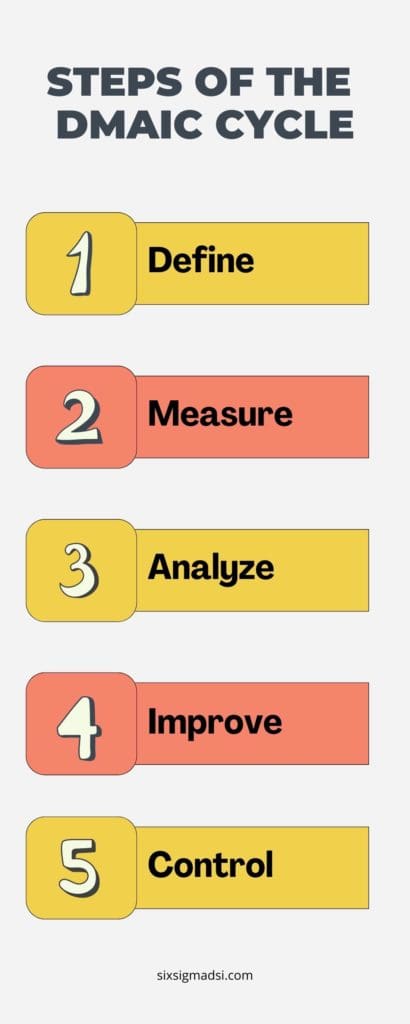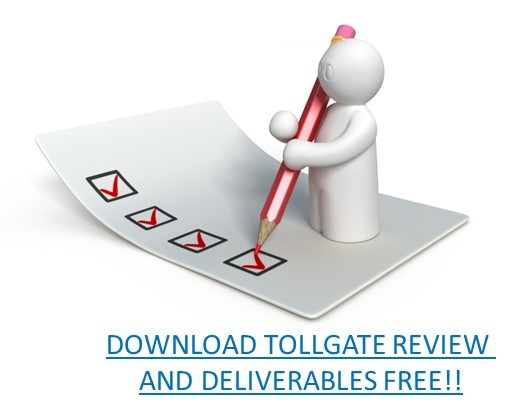Table of contents
Six Sigma Quick Win Tollgate Review
A Tollgate Review will help you determine if the goals in a Quick Win Project management have been completed. The meaning of a Six Sigma Quick Win Tollgate Review is like a checkpoint at which the various team members pass with a project Champion and determine whether the work has been performed as indicated in the project plan and if the objectives mentioned have been achieved.
Tollgates and Tollgate Reviews have been associated with the Six Sigma DMAIC method. DMAIC stands for Define Measure Analyze Improve and Control.
These steps or phases will guide your Six Sigma project. You must complete a certain number of deliverables and activities in each phase before you can move on to the next. A Tollgate pass is an official process that reviews and evaluates the progress of your project through each DMAIC phase.

You may have the following people present:
- Black Belt
- Project Sponsor
- Project team
- Stakeholders
- Champion
- Senior Staff
- Master Black Belt
- Value chain partners
You will be asked to:
- Present your accomplishments in a formal manner, followed by questions and a discussion.
- Check the status of your project
- Check your progress and aligned activities.
- Re-examine the assumptions in your project charter
- With your Black Belt or Master Black Belt and your Project Sponsor, Senior Staff, or your Champion, make a decision on whether to move forward with the next phase.
You can either decide to cancel the project management or take additional actions to get past the Tollgate.
Here’s a summary of the questions you will be asked by different meanings of Tollgates.
- Define Have both you and your team clearly defined the opportunity in terms of business and customer perspective?
- Measurement: Have you or your team gathered data that will help you understand the process better? Have you established a baseline for the current performance of your process?
- Analyze Has your team and you identified the critical factors (critical Xes), which have the greatest impact on the process performance? Have you validated the root causes?
- Improve Have your team and you developed improvement solutions for the critical Xes?
- Control: Has your team and you implemented a solution, as well as a plan of control to ensure that the process is robust enough to change?
- Validate While not part of the DMAIC method, you might be asked, after a year, to validate your results. The following questions may be asked: “Is the project still under control?” Are the benefits being realized?”
The average time it takes to review a Tollgate is between 30-60 minutes. Meaning that the following is the recommended agenda for tollgate reviews:
- Tollgates have different objectives.
- 15-30 minutes project presentation
- Note any changes made to the Project Charter
- Project benefit update
- Follow the DMAIC roadmap
- Results, tools, and conclusions
- Review project status
- Project Plan Barriers and Issues
- Review project plans
- Tollgate Review Questions and Discussion
- Tollgate decision
- Next steps and action items to be taken

Has the “Project Charter” been developed?
(The following questions should help determine the answer)
- Business Case: What are the compelling business reasons for embarking on this project? Is the project linked to key business goals and objectives?
- What key business process output measure(s) will the project leverage and how?
- What are the rough order estimates on cost savings/opportunities on this project?
- Problem Statement (Starting Line): What specifically is the problem?
- Where does it occur?
- When does it occur?
- What is its extent?
Goal Statement (Finish Line)
- What is the goal or target for the improvement team’s project?
- Do the problem and goal statements meet the SMART criteria (specific, measurable, attainable, relevant, and time-bound)?
- Has anyone else (internal or external to the organization) attempted to solve this problem or a similar one before? If so, what knowledge can be leveraged from these previous efforts?
- How will the project team and the organization measure the complete success of this project?
Project Scope
- What are the physical boundaries of the scope?
- What is in bounds and what is not?
- How does the project manager ensure against scope creep?
- Is the project scope manageable? What constraints exist that might impact the team?
Milestones
- When was the project start date?
- When is the estimated completion date?
- Is the project currently on schedule according to the plan?
- Has a project plan with milestones been developed?
- How will variation in the actual durations of each activity be dealt with to ensure that the expected project completion date is met?
Do we understand the Customers’ Requirements?
- Have the customer’s been identified?
- Has the improvement team collected the ‘voice of the customer’ (obtained feedback – qualitative and quantitative)?
- What customer feedback methods were used to solicit their input?
- Have the customer needs been translated into specific, measurable requirements?
Performance Baseline
- What is the current process performance baseline?
- How large is the gap between current performance and customer-specified (goal) performance?
Designing the “Implementation Plan”
- Has the team developed an implementation plan?
- What poka-yoke or error-proofing will be done to address some of the discrepancies observed in the ‘as is’ process?
- How does the solution remove the key sources of variation discovered in the analysis phase?
- What communications are necessary to support the implementation of the solution?
- How will the team or the process owner(s) monitor the implementation plan to see that it is working as intended?
- What is the team’s contingency plan for potential problems occurring in implementation?
- How will the organization know that the solution worked?




















